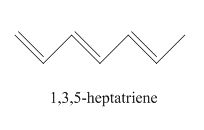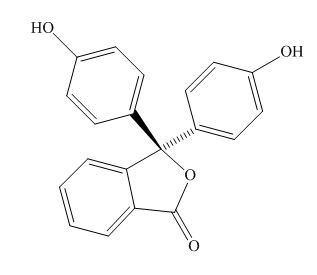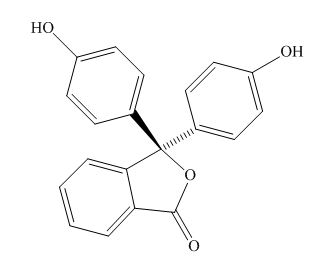
(a)
To determine: The experiment that determines the energy absorbed by the given compounds.
(a)
Answer to Problem 1DE
Solution: The experiment that determines the energy absorbed by the given compounds is UV-visible spectrometry.
Explanation of Solution
The energy absorbed by the given compound is calculated by the formula,
Plank’s constant and
The experiment that makes possible to measure the wavelength of the light absorbed by the compound is UV-visible spectrometry.
The maximum wavelength absorbed by the solution of the compound is determined and substituted in the above formula.
Thus, the energy absorbed by the compound is determined.
The experiment that determines the energy absorbed by the given compounds is UV-visible spectrometry.
(b)
To determine: The dependency of the excitation energy on the length of the conjugated system.
(b)
Answer to Problem 1DE
Solution: The increase in the length of the conjugated system causes decreases in the excitation energy.
Explanation of Solution
The
The, distance between the ground state and the excited state determines the energy needed for the excitation.
As the length of the conjugated system increases, the distance between the atom in the chain decreases and hence the distance between the ground state and the excited state decreases. Therefore, the excitation energy decreases.
Thus, the increase in the length of the conjugated system causes decreases in the excitation energy.
The increase in the length of the conjugated system causes decreases in the excitation energy.
(c)
To determine: The additional molecule required to test the energy dependency on the length of the conjugated system.
(c)
Answer to Problem 1DE
Solution: The additional molecule required to test the energy dependency on the length of the conjugated system are
Explanation of Solution
The dependency of the excitation energy on the length of the conjugated system is tested by measuring the
The examples are,

Figure 1
Phenolphthalein

Figure 2
Lycopene

Figure 3
The above examples absorb light of different wavelength, depending upon their conjugation length.
Phenolphthalein,
(d)
To determine: The dependency of the absorption of energy on the delocalization of the electron.
(d)
Answer to Problem 1DE
Solution: The dependency of the absorption of energy on the delocalization of the electron is explained using phenolphthalein.
Explanation of Solution
The excitation of the
The structure of the phenolphthalein is,

Figure 2
Phenolphthalein is acidic in nature due to the presence of the phenolic hydroxide group. Thus, in the acidic solution, the hydroxide group is not ionised. In the basic solution, the hydoxide group ionizes to form oxide ion that takes part in the resonance and stabilizes the
Phenolphthalein in the acidic solution is colorless, while that in the basic solution is colored. The reason for the same is that, the delocalisation of the electrom takes place in the basic solution and is absent in the acidic solution. Hence, unless the electrons are not delocalised, excitation of the electrons does not take place.
The dependency of the absorption of energy on the delocalization of the electron is explained using phenolphthalein.
Want to see more full solutions like this?
Chapter 9 Solutions
Laboratory Experiments For Chemistry: The Central Science, Si Edition
- The product on the right-hand side of this reaction can be prepared from two organic reactants, under the conditions shown above and below the arrow. Draw 1 and 2 below, in any arrangement you like. 1+2 NaBH₂CN H+ N Click and drag to start drawing a structure. X $arrow_forwardExplain what is the maximum absorbance of in which caffeine absorbs?arrow_forwardExplain reasons as to why the amount of caffeine extracted from both a singular extraction (5ml Mountain Dew) and a multiple extraction (2 x 5.0ml Mountain Dew) were severely high when compared to coca-cola?arrow_forward
- Protecting Groups and Carbonyls 6) The synthesis generates allethrolone that exhibits high insect toxicity but low mammalian toxicity. They are used in pet shampoo, human lice shampoo, and industrial sprays for insects and mosquitos. Propose detailed mechanistic steps to generate the allethrolone label the different types of reagents (Grignard, acid/base protonation, acid/base deprotonation, reduction, oxidation, witting, aldol condensation, Robinson annulation, etc.) III + VI HS HS H+ CH,CH,Li III I II IV CI + P(Ph)3 V ༼ Hint: no strong base added VI S VII IX HO VIII -MgBr HgCl2,HgO HO. isomerization aqeuous solution H,SO, ༽༽༤༽༽ X MeOH Hint: enhances selectivity for reaction at the S X ☑arrow_forwardDraw the complete mechanism for the acid-catalyzed hydration of this alkene. esc 田 Explanation Check 1 888 Q A slock Add/Remove step Q F4 F5 F6 A བྲA F7 $ % 5 @ 4 2 3 & 6 87 Click and drag to start drawing a structure. © 2025 McGraw Hill LLC. All Rights Reserved. Terms of Use | Privacy Ce W E R T Y U S D LL G H IK DD 요 F8 F9 F10 F1 * ( 8 9 0 O P J K L Z X C V B N M H He commandarrow_forwardExplanation Check F1 H₂O H₂ Pd 1) MCPBA 2) H3O+ 1) Hg(OAc)2, H₂O 2) NaBH4 OH CI OH OH OH hydration halohydrin formation addition halogenation hydrogenation inhalation hydrogenation hydration ☐ halohydrin formation addition halogenation formation chelation hydrogenation halohydrin formation substitution hydration halogenation addition Ohalohydrin formation subtraction halogenation addition hydrogenation hydration F2 80 F3 σ F4 F5 F6 1 ! 2 # 3 $ 4 % 05 Q W & Å © 2025 McGraw Hill LLC. All Rights Reserved. F7 F8 ( 6 7 8 9 LU E R T Y U A F9arrow_forward
- Show the mechanism steps to obtain the lowerenergy intermediate: *see imagearrow_forwardSoap is made by the previous reaction *see image. The main difference between one soap and another soap isthe length (number of carbons) of the carboxylic acid. However, if a soap irritates your skin, they mostlikely used too much lye.Detergents have the same chemical structure as soaps except for the functional group. Detergentshave sulfate (R-SO4H) and phosphate (R-PO4H2) functional groups. Draw the above carboxylic acidcarbon chain but as the two variants of detergents. *see imagearrow_forwardWhat are the reactions or reagents used? *see imagearrow_forward
 ChemistryChemistryISBN:9781305957404Author:Steven S. Zumdahl, Susan A. Zumdahl, Donald J. DeCostePublisher:Cengage Learning
ChemistryChemistryISBN:9781305957404Author:Steven S. Zumdahl, Susan A. Zumdahl, Donald J. DeCostePublisher:Cengage Learning ChemistryChemistryISBN:9781259911156Author:Raymond Chang Dr., Jason Overby ProfessorPublisher:McGraw-Hill Education
ChemistryChemistryISBN:9781259911156Author:Raymond Chang Dr., Jason Overby ProfessorPublisher:McGraw-Hill Education Principles of Instrumental AnalysisChemistryISBN:9781305577213Author:Douglas A. Skoog, F. James Holler, Stanley R. CrouchPublisher:Cengage Learning
Principles of Instrumental AnalysisChemistryISBN:9781305577213Author:Douglas A. Skoog, F. James Holler, Stanley R. CrouchPublisher:Cengage Learning Organic ChemistryChemistryISBN:9780078021558Author:Janice Gorzynski Smith Dr.Publisher:McGraw-Hill Education
Organic ChemistryChemistryISBN:9780078021558Author:Janice Gorzynski Smith Dr.Publisher:McGraw-Hill Education Chemistry: Principles and ReactionsChemistryISBN:9781305079373Author:William L. Masterton, Cecile N. HurleyPublisher:Cengage Learning
Chemistry: Principles and ReactionsChemistryISBN:9781305079373Author:William L. Masterton, Cecile N. HurleyPublisher:Cengage Learning Elementary Principles of Chemical Processes, Bind...ChemistryISBN:9781118431221Author:Richard M. Felder, Ronald W. Rousseau, Lisa G. BullardPublisher:WILEY
Elementary Principles of Chemical Processes, Bind...ChemistryISBN:9781118431221Author:Richard M. Felder, Ronald W. Rousseau, Lisa G. BullardPublisher:WILEY





